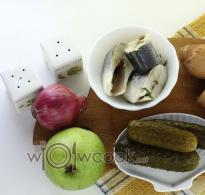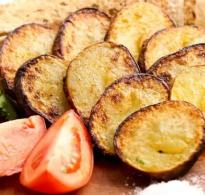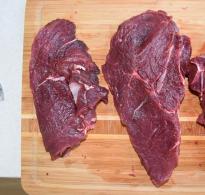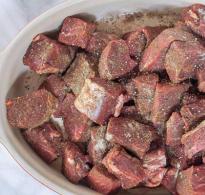How to distinguish false chanterelles. What chanterelles look like: photo, description of mushrooms
If you went to the forest for chanterelle mushrooms, but did not find it, do not despair. Walk the next day in the same places. You may well find yellow delicious mushroom where yesterday they didn't even smell! Yes, this is exactly what these wonderful mushrooms have. They very often "pop out" in just one night.
Chanterelles are considered one of the most delicious mushrooms growing in our latitudes. They can be of different shades - there is a light variety that has a pale yellow color, and a brighter one - a red hue, similar to the yolk in color.
There are many varieties of this mushroom in the world. All of them belong to the same family of the Lisichkovs. We most often have only two types:
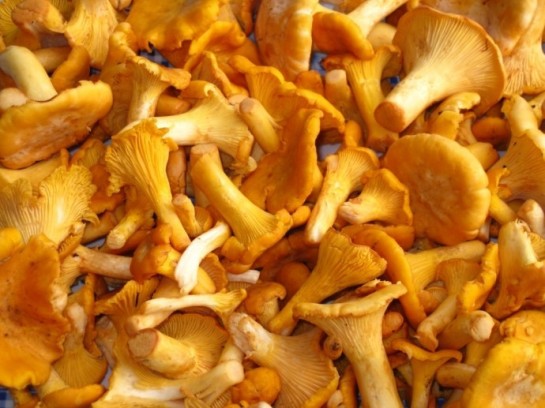
The chanterelle, which is also called yellow or real, has a brighter color.
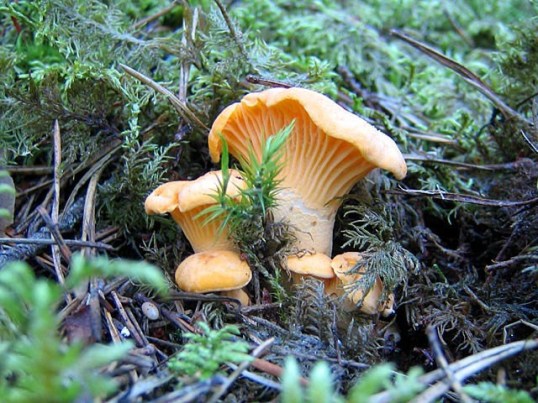
other names for which are winter, autumn, funnel-shaped. Has a pale color.
Chanterelles are mushrooms with excellent qualities. They are delicious and safe. They are practically not eaten by worms and insects.
Why is the chanterelle called?
Why did these mushrooms get this interesting name? Is it because of its resemblance to a small fluffy animal? Partly yes. Firstly, in the old days these mushrooms were called in a completely different way - cockerels. Then the yellow color had a completely different name - "fox". From him came the name of the cunning little animal - "fox" or "fox". Accordingly, mushrooms were also named so due to their extraordinary beautiful color.
The yellowness of their chanterelles is obliged high content carotene. It is he who gives a bright color to the carrots.
But it is worth remembering the cunning disposition of mushrooms, similar to the animal of the same name. Chanterelles know how to hide well, despite their bright enough color.
Description of the mushroom with a photo
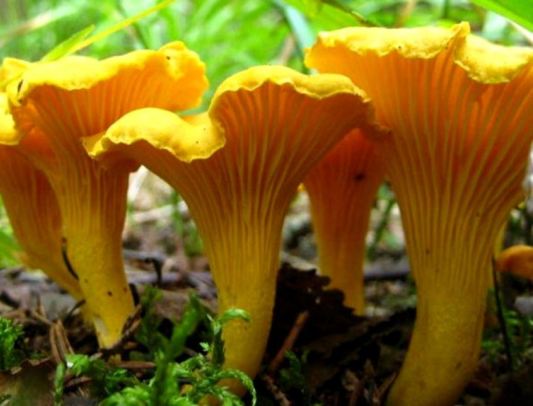
Previously, the chanterelle was classified as a lamellar mushroom. But today the opinion on this matter has changed, it was recognized as a non-plate mushroom. It is very important to be able to distinguish a chanterelle from false mushrooms that may be similar to her, but hazardous to health. Therefore, let's take one fungus - the common chanterelle, and consider it in more detail.
Hat
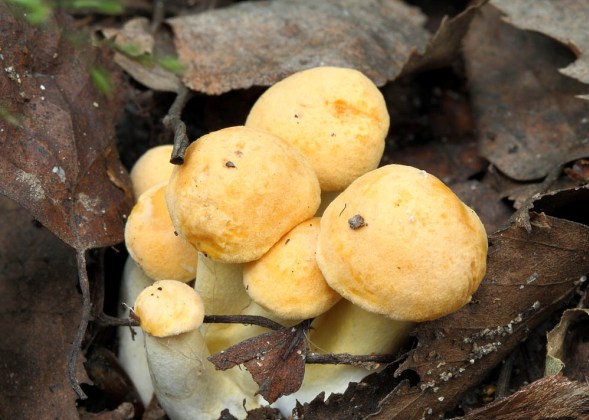
Young chanterelles
Let's start with the hat that the mushroom picker in the forest will see first of all. In young fungi, it has a smooth surface, convex shape. Small chanterelles practically consist of one cap, the leg cannot be seen from them - it is too tiny, hidden under the "umbrella".
Over time, the cap loses its ideal shape, its edges become wavy. An adult mushroom is distinguished by its middle. A point appears in the very center of the cap, as if pressed inward. Therefore, large chanterelles become a little like a funnel. Adult mushrooms can have caps up to 7 cm in size.

Family of chanterelles
Plates are hidden under the mushroom cap. But, since today the chanterelle belongs to non-lamellar mushrooms, then this part would be more correctly called outgrowths of the fruiting body. They have a wrinkled shape. When you press on them with your finger or fingernail, the color should not change to darker or lighter.
Inside the mushroom, the most delicious thing awaits us - the pulp. The chanterelle has the same color as the surface. Yellow, sometimes brighter or paler, the flesh does not change its hue in the places of the cut. Her smell is simply wonderful, characteristic of edible mushrooms... The pulp does not crumble, but over time it loses its tenderness. Old chanterelles become harsh, "rubbery". In addition, with age, these mushrooms acquire the ability to absorb more moisture and begin to soak quickly in the rain.
Leg

And finally, we got to the last part of the chanterelle - its legs. As a rule, it has a solid shape, inside it is not hollow, it consists entirely of pulp. Its shape is such that it slowly turns into outgrowths, which, in turn, end at the outer edge of the cap. The size of the stem, as, indeed, of the whole mushroom, depends on the area where it grows. But on average, the leg can reach 8 cm in an adult fungus that grows in wetlands.
How to cook
Chanterelles are suitable for preparing a wide variety of delicious dishes. With them you can make snacks and soups, sandwiches, hot blues, etc. Their taste is simply incomparable. Therefore, these mushrooms are very popular.
This mushroom is widely used by culinary specialists in European countries. Its popularity is also due to its content nutrients- zinc, copper, amino acids, as well as vitamins PP, A, B1.
The taste of chanterelles is also different because such mushrooms are practically not grown in an artificial environment. They can only be enjoyed after a pleasant and successful trip to the forest!
Fried
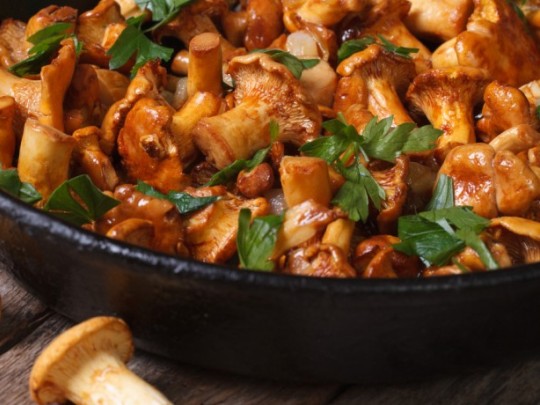
Fried mushrooms are one of many people's favorite foods. Chanterelles are great for frying or stewing. Moreover, sour cream is most often added to them. This dish can be ordered in many expensive restaurants. Or you can just cook at home, it's not difficult and fast enough.
First of all, the mushrooms must be boiled. After that, they are washed and placed in a saucepan. The container is covered with a lid on top. So the mushrooms must be stewed for about half an hour. After this time has elapsed, it's time to add the main spice - salt, to taste. Now you can add other ingredients. These include fried onions, sour cream. Combining all this with our chanterelles, we bring to a boil. All - chanterelles in sour cream are already ready. You can decorate them with greens. By the way, many people point out one secret. To make the dish tastier, the onions must not be fried on vegetable oil, but on bacon.
Some people prepare this dish differently. Chanterelles are simply washed well, cleaned. Without boiling them first, the mushrooms begin to stew in sour cream or cream. This process should last at least 45-60 minutes. At the very end, you can add a couple more spoons of sour cream with a high percentage of fat, but so that it does not have time to boil over with the mushrooms.
Baked
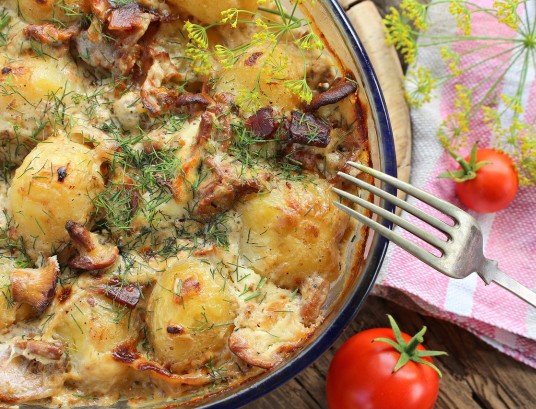
Baked chanterelles deserve no less attention. To cook such, you need to peel the mushrooms well, rinse and chop finely.
Then they need to be boiled, but not for long - only about 5 minutes. After draining the water in which the mushrooms were cooked, they need to be poured into the pan.
Add a sufficient amount of vegetable oil there and simmer the chanterelles for about 25-35 minutes. In this case, the mushrooms must be covered with a lid.
After completing this process, the chanterelles need to be salted. Now it's time to put the mushrooms in a baking dish, of course, greased beforehand.
On top is laid out a mass of grated hard cheese mixed with mayonnaise. Mushrooms are cooked in the oven for just 15-20 minutes.
Casserole
The same ingredients can be used to make a casserole, alternating layers of mushrooms and cheese with mayonnaise. The last one should be on top. The casserole is considered ready when the cheese layer acquires a golden brown crust.

Chanterelle liquid dishes are prepared the most different ways... Here is one of them. The chanterelles must be washed and cut. You also need to prepare the onion - peel, chop, fry in bacon or vegetable oil. When everything is ready, combine the onions and mushrooms.
Now you need to add a little water to the composition - only about 3 teaspoons. It is necessary to extinguish all this on low heat up to half an hour, maybe a little less. The preparation for the soup is ready.
You can also add other ingredients to it, according to your taste - diluted flour, which will give thickness, pearl barley.
From vegetables, chopped potatoes, carrots, pre-grated, are added to such a soup. This delicious soup should be served with sour cream and fresh chopped herbs.
It is worth noting that chanterelles themselves give a wonderful broth - very fragrant, rich. Therefore, it is not necessary to fry the onion, not everyone likes it, and may slightly overpower the aroma of the mushrooms.
Do not forget that when cooking, you need to drain the first water - after the mushrooms have just boiled. They are washed and filled with fresh clean water.
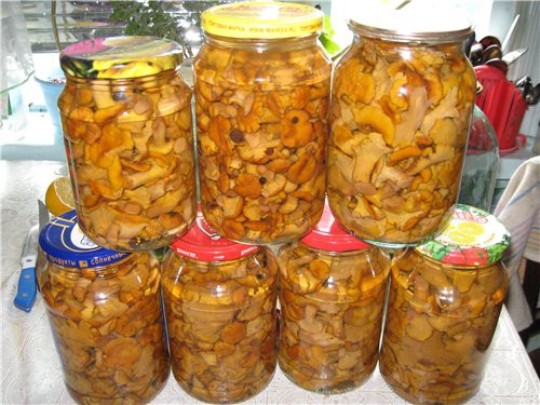
Who doesn't love pickled mushrooms? And chanterelles in this regard are simply incomparable. They are not only delicious, but also look very nice on the table.
To prepare such a miracle, you can use following recipe... Chanterelles are thoroughly cleaned and washed in several waters. The output should be about 1 kg of raw material. Then the yellow mushrooms must be boiled - not for long, for about 10-20 minutes. When the mushrooms are ready, they need to be drained. A colander is perfect for this. Now the chanterelles need to be poured with clean water and boiled again, for about half an hour. This pure liquid with chanterelle broth will later be used to make the marinade.
So, we make the marinade as follows.
For 1 liter of liquid, you need to take a bay leaf, 1 tsp. sugar, cloves (2 pieces) and a few pieces of whole allspice... As for salt, 1 tbsp is enough. l. Bay leaf can be obtained after a while. He will have time to give off his scent in 20 minutes. And if left before cooling, it can spoil the overall taste a little with too strong a smell. Another important ingredient is vinegar. 8% will do, about 2/3 of a regular glass.
When everything is ready, the mushrooms along with fragrant marinade are laid out in glass jars... You need to keep such a dish in a cold place.
It is important to note that if you cover pickled chanterelles or other mushrooms metal lids, then you need to eat them as soon as possible - even during the current year. Otherwise, there is a risk of botulism.

Many people note that after freezing, chanterelles lose their taste. They seem to acquire bitterness. But what is to be done? Often lucky mushroom pickers collect a lot of yellow mushrooms - a bucket or even a few! They can be kept fresh for no more than a day, after which they begin to deteriorate and lose their value. Of course, you can eat a little by making a casserole or soup, stewed mushrooms, or pickle. But in order to eat chanterelles in winter as if they had just been brought from the forest, it is best to freeze them. And don't believe the one who said they would taste bitter. These people just don't know how to freeze chanterelles properly!
First of all, you need to properly prepare the mushrooms. This applies not only to chanterelles, but also to other forest dwellers with a hat.
- Firstly, if you do not have the strength or time to clean them immediately after harvesting, then it is necessary to leave the mushrooms in a cold place. In the warmth, chanterelles very quickly lose their qualities.
- Secondly, you need to carefully sort out your prey and sort by size. Old chanterelles can be immediately sent to the kitchen for fast food... But the young ones are for freezing.
- And, thirdly, the mushrooms need to be cleaned and rinsed, preferably under running water, and not in a basin. But you should not soak them. They will gain moisture, this is superfluous for freezing.
On the contrary, the washed mushrooms must be drained and held for a little in a colander so that the liquid is well glass. After that, you can lay out the chanterelles on a towel, for example, a paper one. They will dry well and be ready to freeze.
There are two ways to freeze chanterelles and keep them longer. According to the first, you need to take packages or containers into which washed and dried mushrooms are poured. But in this case, it is not always possible to avoid the appearance of buckwheat, which has already been discussed before.
The second method allows you to prevent the appearance of bitterness. But mushrooms can lose more of their beneficial properties. Before freezing, it is recommended to pour the chanterelles with water and bring to a boil. You can salt them a little. Mushrooms are boiled for freezing for no more than 20 minutes. Next, the chanterelles need to be drained, rinsed and dried by placing them on a paper napkin. Now you can put the mushrooms in a thin layer on a board or pallet and send them to the freezer. After they have hardened, the mushrooms are placed in containers or bags for longer storage.
In both cases, one point is very important to keep in mind. It is impossible to defrost and freeze mushrooms several times, including chanterelles. Therefore, when using the first method, the portions should be such that all the mushrooms are used at once. And the second method allows you to simply pour off the right amount chanterelles without defrosting them. By this, by the way, this method of freezing also compares favorably with another.
How long can chanterelles be kept frozen? According to expert mushroom pickers, you shouldn't keep them longer than 90 days. But for this we freeze the mushrooms so that you can enjoy them throughout the entire time until it comes new season chanterelles. Indeed, they can be stored longer. But you cannot argue with some arguments: over time, the qualities of mushrooms are lost. Even in the freezer, it cannot be stored for very long time excellent taste mushrooms, their aroma.
Chanterelles are clear favorites among many mushroom pickers. And this is not surprising, given all their qualities. But there is one "but" to which you need to pay attention. These mushrooms have a double - the mushroom is not edible. Very often people confuse a real chanterelle with him, especially inexperienced mushroom pickers. In this case, instead of delicious dishes from the fragrant chanterelle, you can get poisoning and indigestion. Therefore, it is worth going to the forest for chanterelles with a person who knows these mushrooms well. Or you can preliminarily study everything about yellow mushrooms and their counterparts.

You can confuse fox mushrooms with a false chanterelle. it lamellar mushrooms, which belong to the Pig family.
There are several signs that distinguish these two mushrooms:
Smell
In false chanterelles, it is quite unpleasant;
Color
The false chanterelle has a brighter hat. Its color is not yellow, but a bright ocher-orange. The plates also differ in color. They can be orange with a reddish tint. The flesh of a false chanterelle sometimes has a pink color.
Leg
She is at false mushroom fragile enough. In addition, the stem is darker towards the bottom, at the base.
The form
False chanterelles do not have such pronounced waves on the cap as real ones.
Today, most experts believe that the false chanterelle is not poisonous. But this mushroom is much worse quality than edible varieties of chanterelles. Eating false yellow mushroom can lead to stomach upset.
Video about mushrooms growing in central Russia - Chanterelles: video
Chanterelles (lat. Cantharellus) - mushrooms that belong to the department Basidiomycetes, Agaricomycetes class, Cantarella order, Chanterelle family, Chanterelle genus. These mushrooms are difficult to confuse with others, as they have an extremely memorable appearance.
Chanterelles - description and photos.
The body of chanterelles in shape resembles the body of cap-pedunculate mushrooms, however, the cap and leg of the chanterelles are one whole, without visible boundaries, even the color is about the same: from pale yellow to orange. The cap of the chanterelle mushroom is 5 to 12 centimeters in diameter, irregular in shape, flat, with curled, open wavy edges, concave or depressed inward, in some mature individuals it is funnel-shaped. People call such a hat "in the shape of an inverted umbrella." The chanterelle cap is smooth to the touch, with a hard-to-peel skin.
The flesh of chanterelles is fleshy and dense, fibrous in the area of the leg, white or yellowish in color, has a sour taste and a weak smell of dried fruits. When pressed, the surface of the mushroom turns reddish.
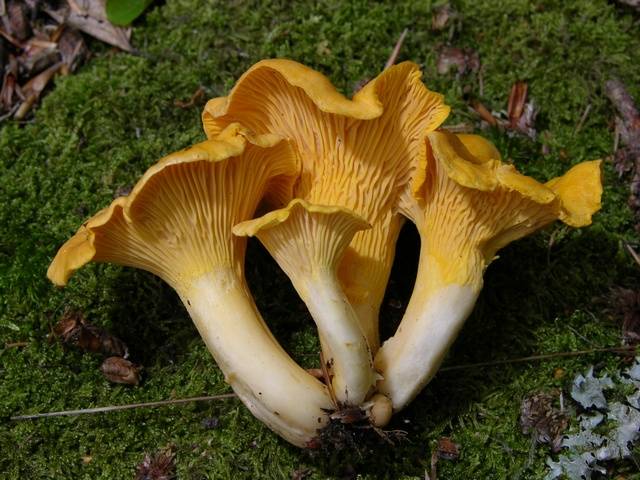
The leg of the chanterelle is most often the same color as the surface of the cap, sometimes somewhat lighter, has a dense, smooth structure, uniform in shape, slightly narrowed to the bottom, 1-3 centimeters thick, 4-7 centimeters long. The surface of the hymenophore is folded, pseudoplastic. It is represented by wavy folds falling along the leg. In some species of chanterelles, it can be venous. The spore powder has a yellow color, the spores themselves are ellipsoidal, 8 * 5 microns in size.
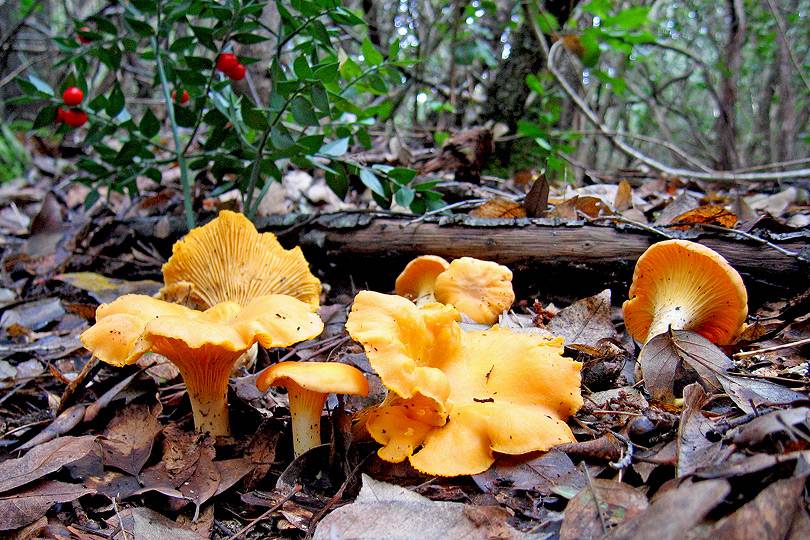
Where, when and in what forests do chanterelles grow?
Chanterelles grow from early June to mid-October, mainly in coniferous or mixed forests, near spruces, pines or oaks. They are found more often in damp areas, in temperate forests among grass, in moss or in a pile of fallen leaves. Chanterelles often grow in numerous groups, appear en masse after thunderstorms.
Chanterelle species, names, descriptions and photos.
There are over 60 species of chanterelles, many of which are edible. Poisonous chanterelles does not exist, although there are inedible species in the genus, for example, the false chanterelle. Also, this mushroom has poisonous counterparts - for example, mushrooms of the genus omphalot. Below are some of the varieties of chanterelles:
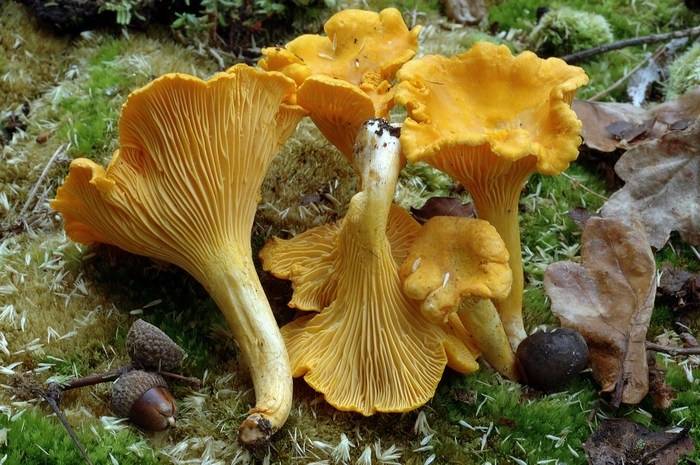
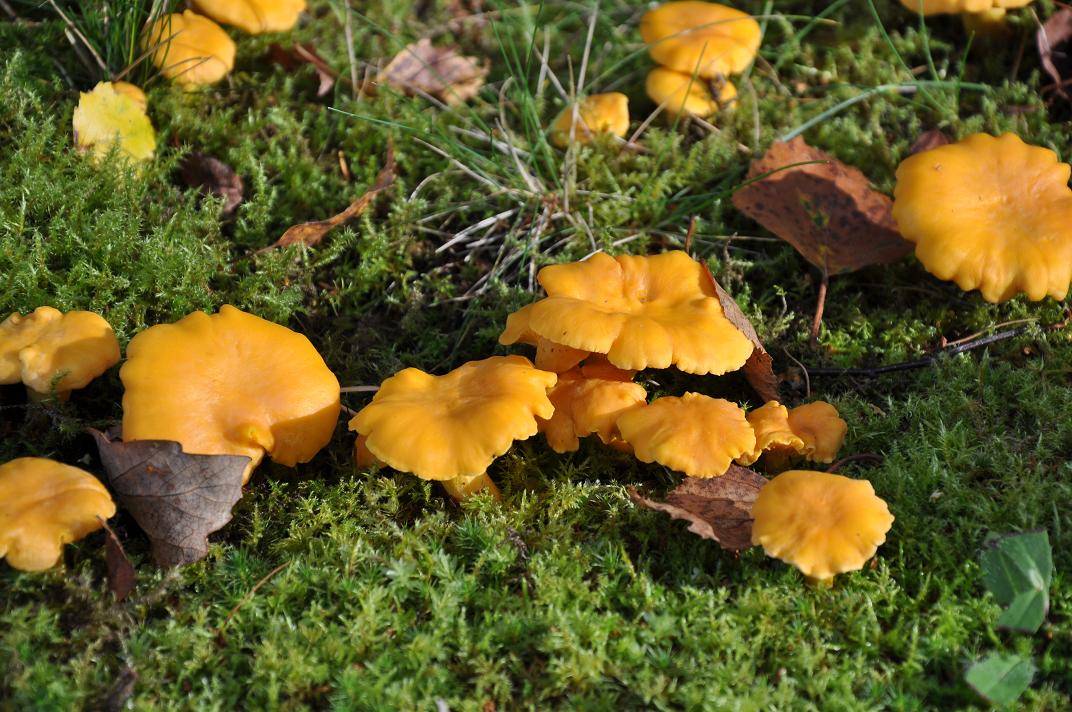
- - an edible mushroom of gray or brown-black color. The hat has a diameter of 1-6 cm, a leg height of 3-8 cm, and a leg thickness of 4-15 mm. The leg is hollow inside. The cap has wavy edges and a depression in the center; the edges of the cap are ash gray. The flesh is firm, gray or brownish in color. The hymenophore is folded. The taste of the mushroom is inexpressive, without aroma. The gray chanterelle grows in mixed and deciduous forests from late July to October. This mushroom can be found in the European part of Russia, Ukraine, America and countries Western Europe... The gray chanterelle is known to few, so mushroom pickers avoid it.
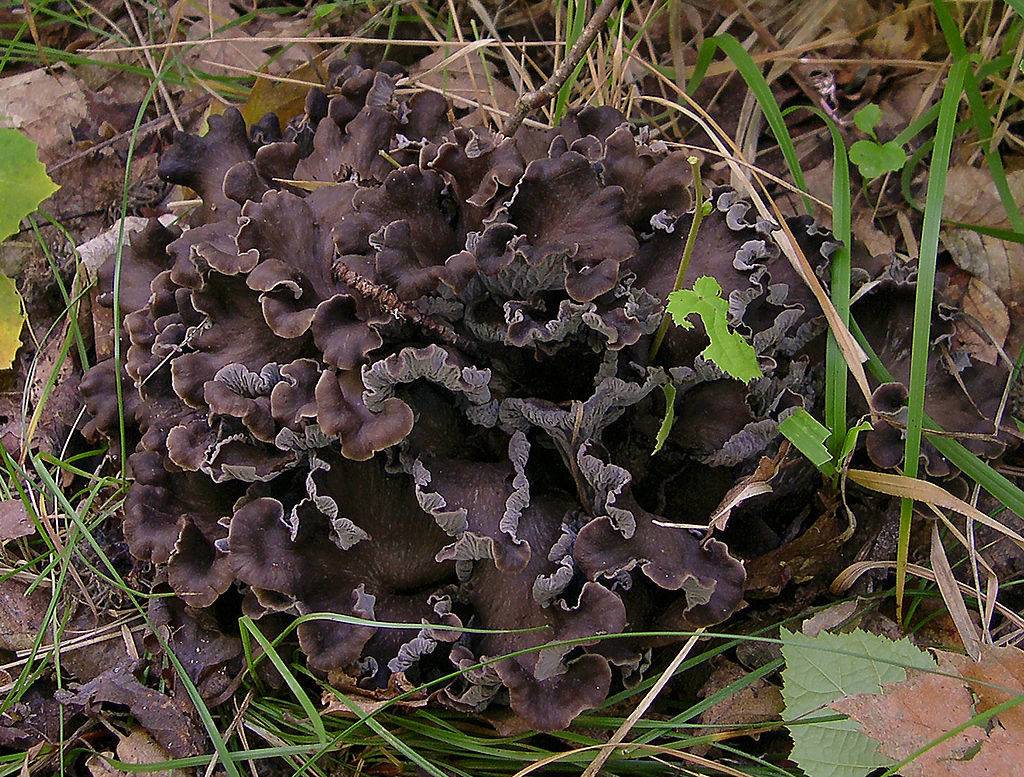
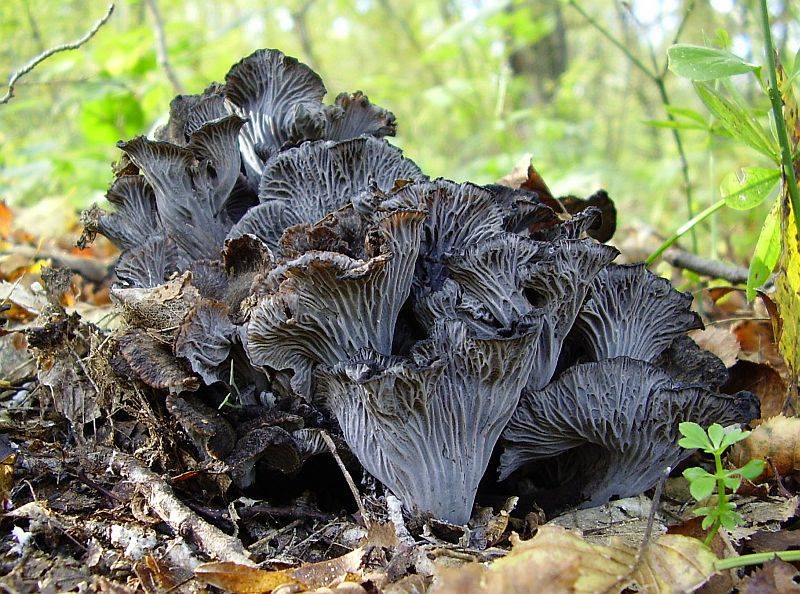
- - Edible mushroom of reddish or pinkish-red color. The diameter of the cap is 1-4 cm, the height of the leg is 2-4 cm, the flesh is fleshy with fibers. The edges of the cap are uneven, curved; the cap itself is concave towards the center. The hymenophore is folded. Thick pseudo-plates have pink color... Spore powder pink-cream. The cinnabar red chanterelle grows in deciduous forests, mainly oak groves, in the eastern part North America... The mushroom picking season is summer and autumn.
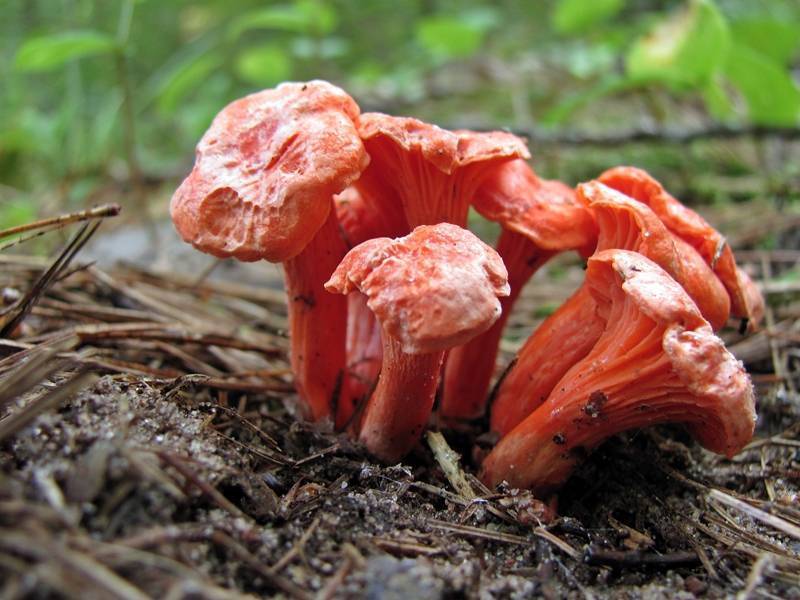
- - an edible but rare mushroom with an orange-yellow or reddish cap. The color of the leg is from light yellow to light orange. Hat diameter 4-5 cm, leg height 2-4 cm, leg diameter 1 cm. Hat young mushroom has a convex shape, which turns into a funnel-shaped with age. The flesh of the cap is light orange when cut, whitish-yellowish at the stem. The smell of the mushroom is pleasant, the taste is sour. The velvety chanterelle grows in the countries of southern and eastern Europe, in deciduous forests on acidic soils. The harvesting season is from July to October.
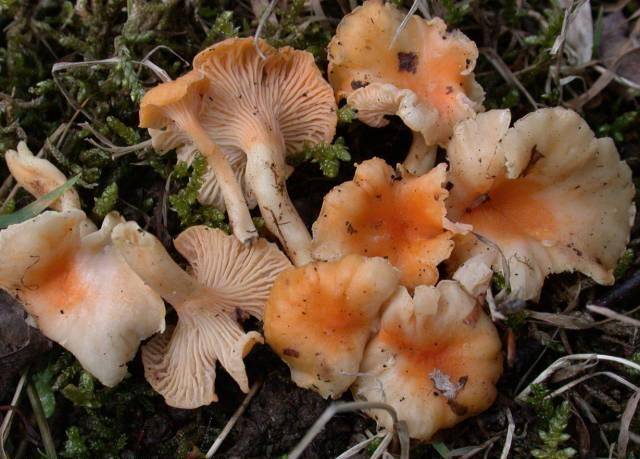
- - edible orange mushroom yellow color... The fruiting body measures from 2 to 10 cm. The cap and stem are combined. The shape of the cap is carved with a wavy edge. The flesh of the mushroom is thick and dense, has pleasant taste and aroma. The diameter of the leg is 1-2.5 cm. The hymenophore is smooth or with small folds. The spore powder has a yellow-orange color, like the mushroom itself. The faceted chanterelle grows in oak groves in North America, Africa, the Himalayas, Malaysia, singly or in groups. You can pick chanterelle mushrooms in summer and autumn.
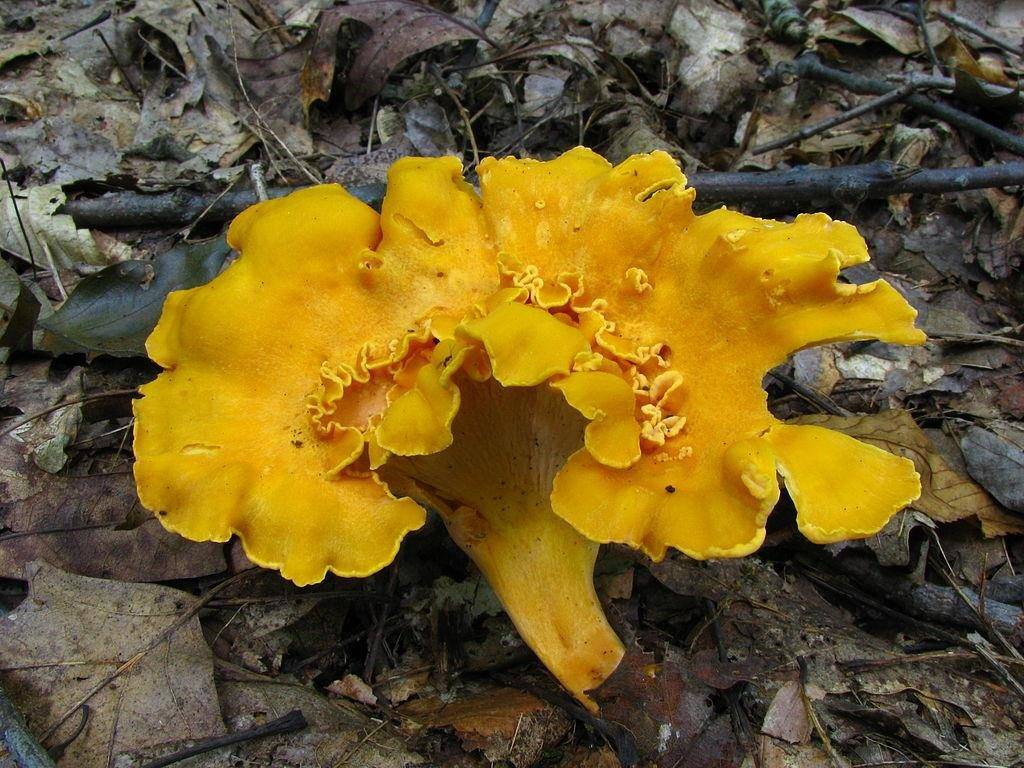
- Chanterelle yellowing (lat... Cantharellus lutescens)- an edible mushroom. The diameter of the cap is from 1 to 6 cm, the length of the leg is 2-5 cm, the thickness of the leg is up to 1.5 cm. The cap and the leg are a single whole, like in other species of chanterelles. Top part caps are yellow-brown, with brown scales. The leg is yellow-orange. The pulp of the mushroom is beige or light orange, has no taste or smell. The spore-bearing surface is most often smooth, less often with folds, and has a beige or yellow-brown tint. Spore powder beige-orange. The yellowing chanterelle grows in coniferous forests, on moist soils, bears fruit until the end of summer.
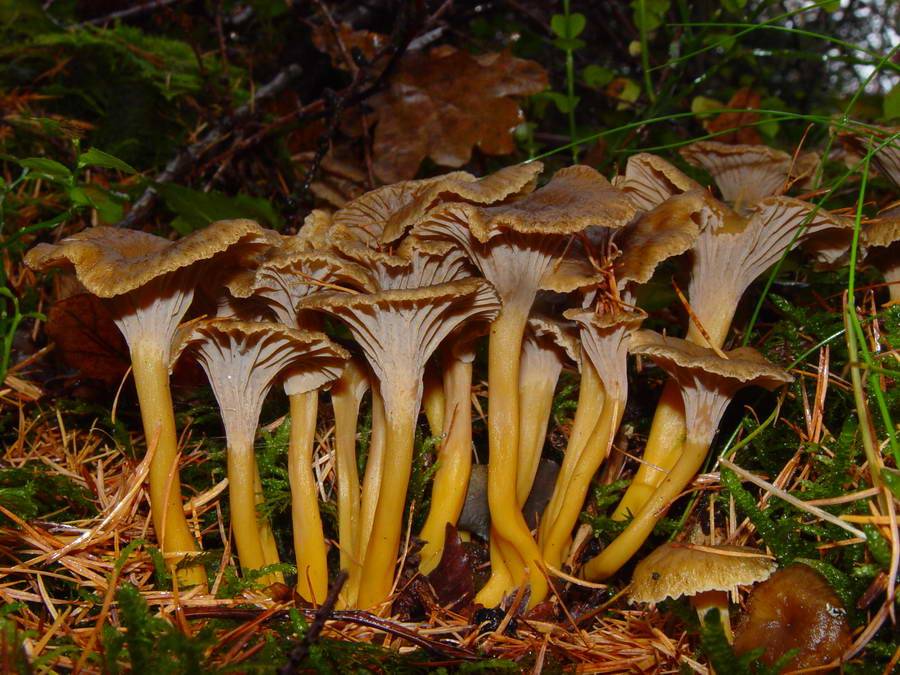
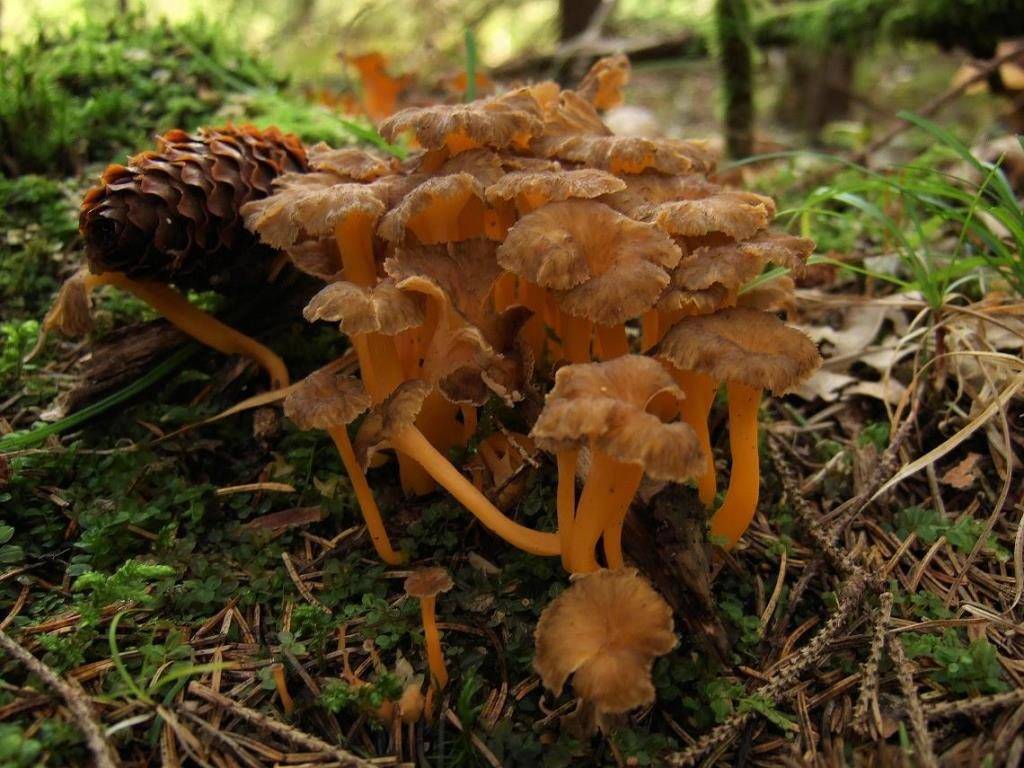
- Tubular chanterelle (funnel chanterelle, tubular cantarell, tubular lobe) (lat.Cantharellus tubaeformis)- an edible mushroom with a cap diameter of 2-6 cm, a leg height of 3-8 cm, a stem diameter of 0.3-0.8 cm. The chanterelle's cap has the shape of a funnel with uneven edges. The color of the cap is grayish yellow. It has dark velvety scales. The tubular stem is yellow or dull yellow. The pulp is firm and white, with a slight bitter taste and pleasant smell land. The hymenophore is yellowish or bluish-gray in color, consists of rare brittle veins. Spore powder beige colour. Tubular chanterelles grow mainly in coniferous forests, sometimes found in deciduous forests in Europe and North America.
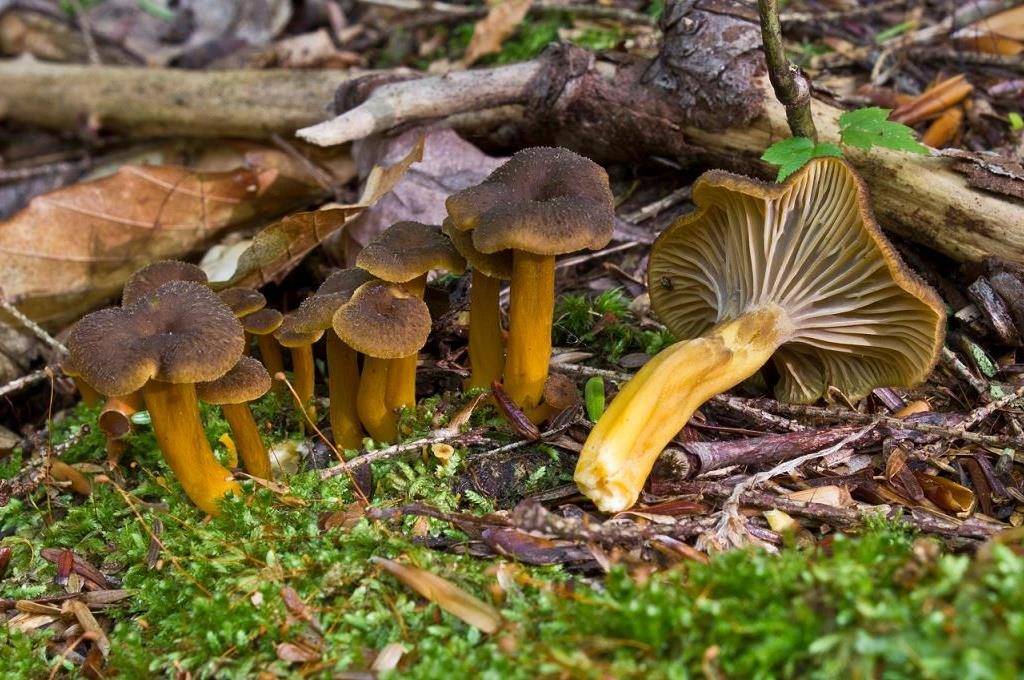
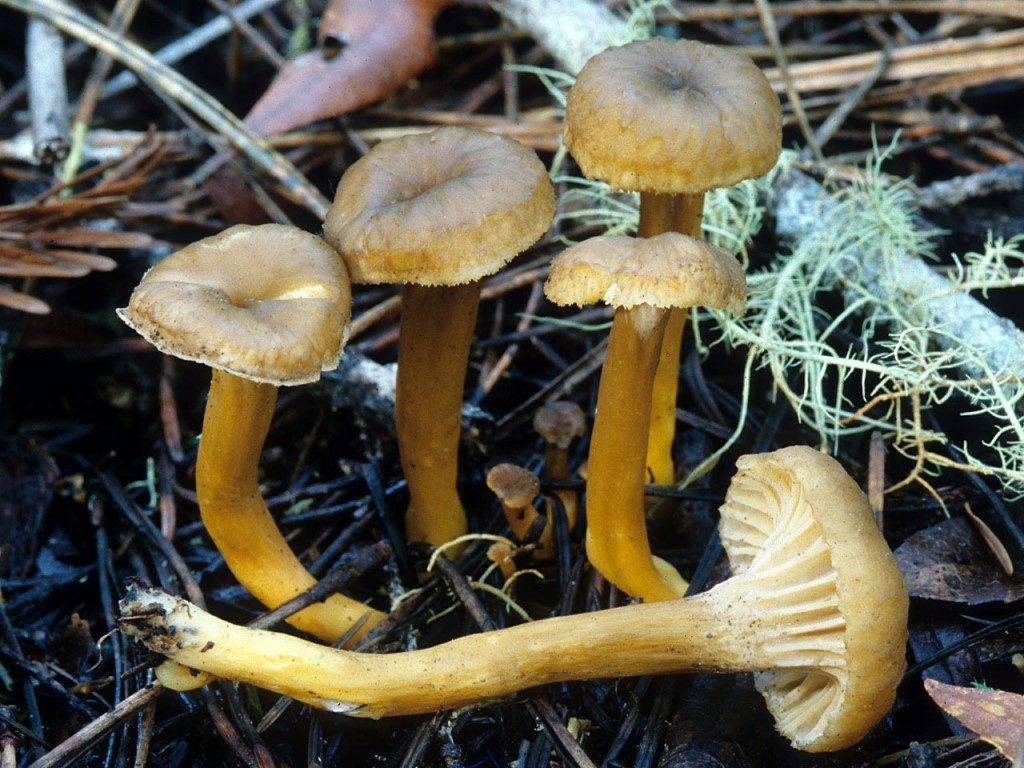
- Chanterelle Cantharellus minor- an edible mushroom, similar to common chanterelle but is smaller. The diameter of the cap is 0.5-3 cm, the length of the leg is 1.5-6 cm, the thickness of the leg is 0.3-1 cm. The cap of a young mushroom is flat or convex; in a mature mushroom, it becomes vase-like. The color of the cap is yellow or orange-yellow. The edge of the cap is wavy. The pulp is yellow, brittle, soft, with a barely perceptible aroma. The hymenophore has the color of the cap. The color of the leg is lighter than that of the cap. The leg is hollow, tapering towards the base. The spore powder is white or yellowish in color. These mushrooms grow in deciduous forests (most often oak) in eastern North America.
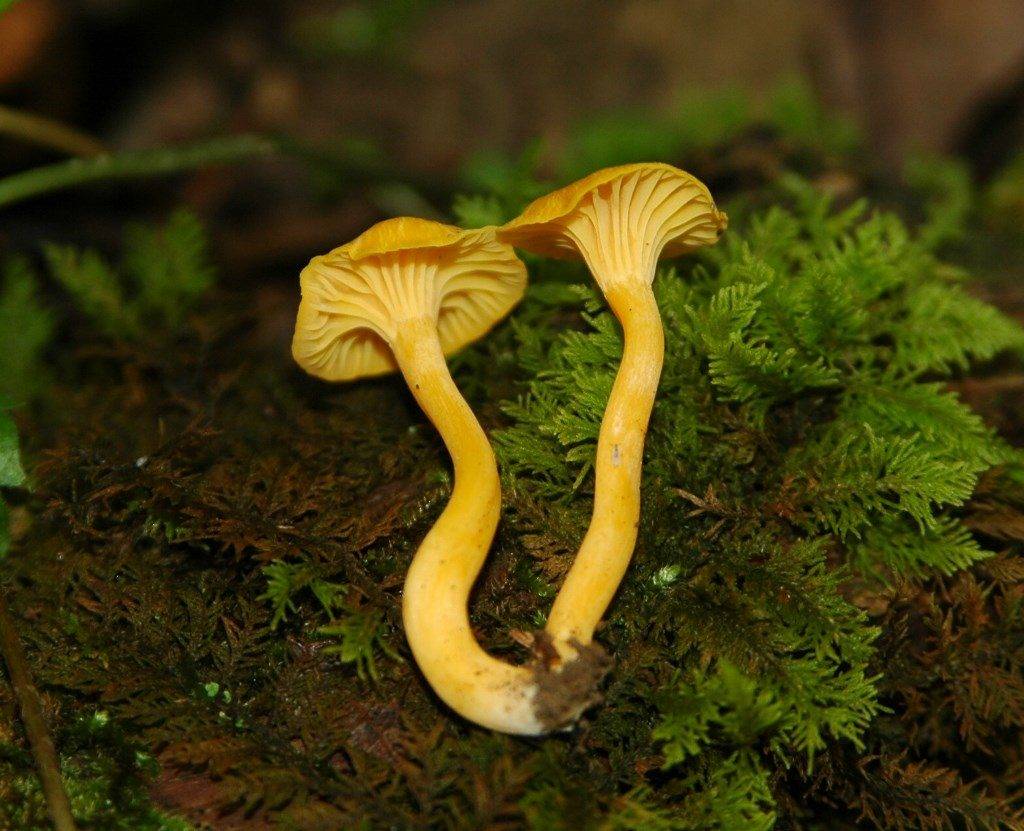
- - an edible mushroom of a whitish or beige color. Turns orange when touched. The wet mushroom becomes light brown. The diameter of the cap is 5-14 cm, the height of the leg is 2-4 cm, the thickness of the leg is 1-3 cm. The cap of a young mushroom is flat with a wavy edge, with the growth of the fungus it becomes funnel-shaped. Velvet scales are located on the skin of the cap. The pulp of the mushroom has no aroma and taste. The hymenophore has narrow folds. The leg is fleshy, white, uneven or smooth. Spore powder is white. The chanterelle mushroom Cantharellus subalbidus grows in the northwestern part of North America and is found in coniferous forests.
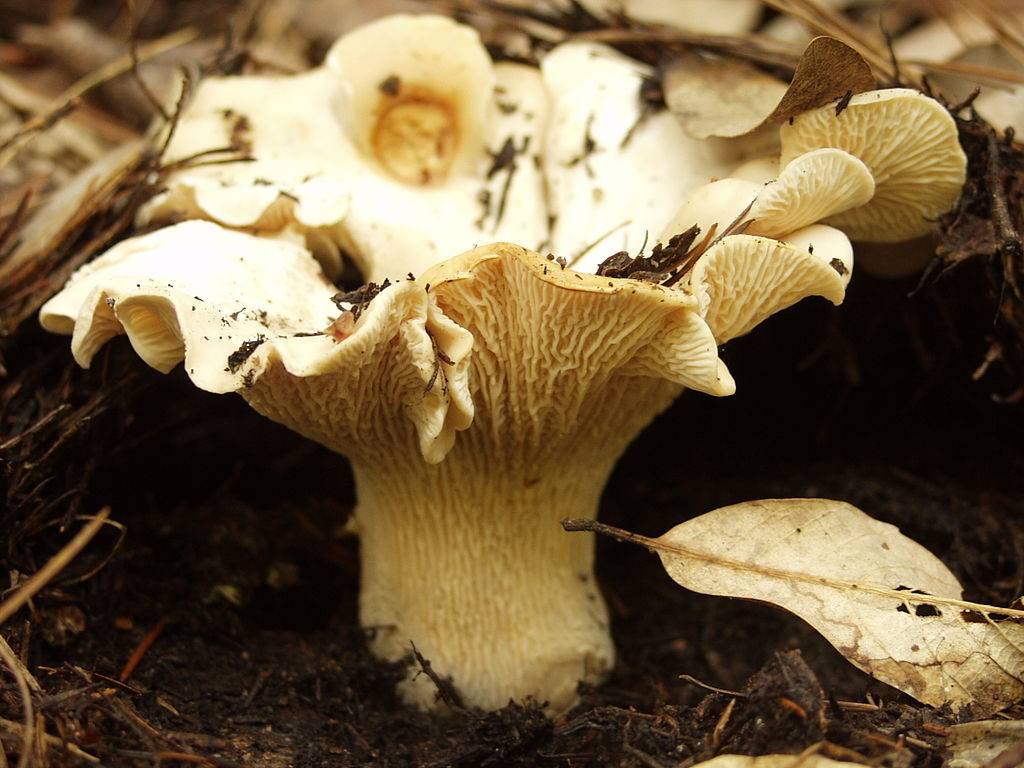
If picking mushrooms is your favorite pastime, then learning more about them will be interesting and useful. The topic of this article is the chanterelle mushroom: where it grows, what is useful, and when to look for it in the forests.
Common chanterelle is a mushroom that belongs to the family of the same name and is the purest of the lamellar. It does not take long to process and it will retain its shape in transit. The name comes from the optimistic bright yellow-red color and graceful shape, which resembles the color of the coat and posture of a graceful fox. A lover of these gifts of nature should know what chanterelles look like in order to collect edible mushrooms.
Edible chanterelles. Appearance
Mushrooms are a cap fused with a stem into a single whole without borders and tapering at the bottom. They can range in shades from light yellow to orange-yellow. The diameter of the elastic cap can reach from 2 to 12 cm. Its surface does not have a regular shape. In the center of the mushroom cap there is a recess, from which uneven areas go, and its edges are bent inward. The chanterelle differs in that when pressed, the dense pulp turns a little red. The leg can be the same color as the cap, or lighter than it. Its thickness is 1-3 cm, and its height is 4-7 cm.
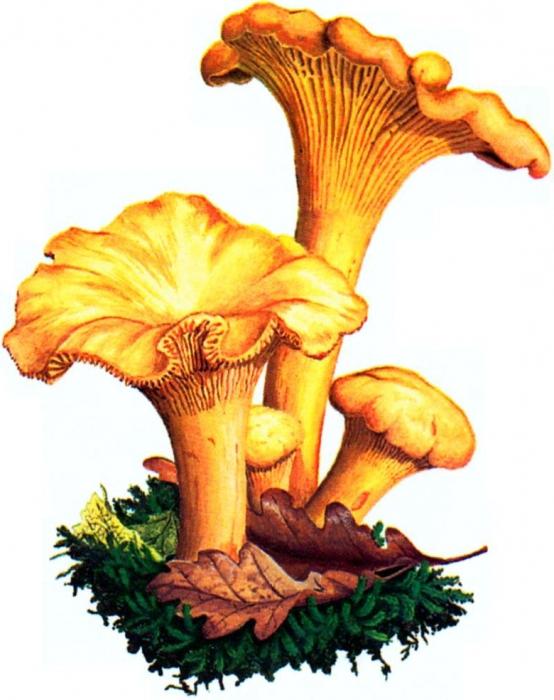
Chanterelle mushroom. Where does it grow?
These "fire" fruits are found mixed and can be found singly or in families. Experienced mushroom pickers it is advised, when you find at least one chanterelle, to inspect the area within a radius of 5-6 meters, because one more mushroom may be encountered. The gifts of the forest in question love warm weather and diffused lighting. Within five days, they grow up to 4 cm in height, and reach full growth in 10 days.
Gray Where does this species grow?
The complete opposite of red chanterelles is gray. Their cap is strongly elongated. This gloomy fruit is called the "pipe of the dead", which came from Germany. He is poorly known to us, so mushroom pickers are wary of him because of appearance and an unpleasant odor.
Gray chanterelles grow in large groups and are found in deciduous and in the vastness of Ukraine, Western Europe, America and in those places of Russia that are close to Europe.
Useful properties of edible chanterelles
Yellow chanterelles contain a lot of vitamins (A, B1, C, PP) and noble elements. Foreign media say that substances are extracted from them, with the help of which they create drugs for radionucleides. They also say that this type of fruit is not exposed to radiation at all.
Are you curious to see what chanterelle mushrooms are? The photo posted above clearly demonstrates three views. Red chanterelles are shown on the left, gray ones in the middle. Be careful: among good mushrooms often come across (photo on the right). They can be distinguished by their overly bright red-orange cap and large plates. It is located on a leg, which is empty inside. This type of chanterelle is not poisonous, but they are not tasty at all.
Now you know what the chanterelle mushroom is, where it grows, which species it is subdivided into and which contains useful substances. After collecting the fruits, they can be salted, dried or fried (previously boiled). Red chanterelles will make an amazing soup, and if you add boletus mushrooms, russula or other mushrooms to them, it will turn out even tastier!
Chanterelles are mushrooms that can be found in different corners the world. Gourmets appreciate them for their excellent taste. These macromycetes are not easy to cultivate. Therefore, people collect them in the forest. However, there is a mushroom that looks like a chanterelle. And not just one. Therefore, "quiet hunters" must be able to distinguish between these macromycetes.
Orange talker (kokoshka)
This chanterelle-like mushroom has an external resemblance to it. For a long time, the orange talker was considered inedible or even poisonous. Some consider it as such now. However, not so long ago, researchers have denied this information. The orange talker was given the status of little value She belongs to the fourth category. Of course, this chanterelle-like mushroom cannot be compared with the last one. taste... Do not discount the previous status of the orange talker. There is no complete certainty that it is absolutely safe, and it will not take too long to return it to the category of inedible or poisonous macromycetes. This chanterelle-like mushroom can cause various digestive disorders in some people.
The orange talker can be found ubiquitous in deciduous, coniferous and mixed forests in the temperate Northern Hemisphere. Prefers pine trees. The talker often settles on stumps, rotten wood, on heaps of dead wood, not far from anthills (a real chanterelle does not grow on a tree). These chanterelle-like mushrooms grow singly, but there are exceptions. They bear fruit between August and October. The peak yield of the orange talker falls at the end of September. The cap of the macromycete is funnel-shaped, velvety, with edges turned down. Her color is light orange. The leg is orange, smooth, thin, often curved. The pulp is viscous, soft, light or yellow. Has no smell and taste. Plates to match the cap, frequent, descending along the stem, forked-branched.
In summary, we can say that in real chanterelles, the color ranges from bilious yellow to yellow ocher, and the fruit bodies are more massive and fleshy.
 Horn-shaped funnel (gray chanterelle)
Horn-shaped funnel (gray chanterelle)
This macromycete is little known. It is edible (fourth category). Its habitat is from the Baltic to the Far Eastern regions. Distinguish funnel from real chanterelle not that difficult in color. It resembles the latter only in form. The mushroom settles in crowded groups, often several dozen. Its fruit body is tubular or funnel-shaped, gradually turning into a leg. The edges of the cap are folded back. The outer surface is grayish-gray and wrinkled, and the inner surface is dark brown. Macromycetes turn completely black after boiling.
 Omphalot olive
Omphalot olive
There are also those similar to chanterelles. However, they do not occur. One of these macromycetes is olive omphalot. It grows in Mediterranean countries and subtropics. This mushroom is deadly poisonous. This one, unlike the real one, grows on trees. The plates of the mushroom are thinner and reach the very edge.
On a fine September day, it's so nice to get out into the forest. Excellent weather, fresh air, an abundance of mushrooms and berries - all these are components of an autumn outing into nature. If you first decided to go out of town as a mushroom picker, then you should approach this business as consciously as possible. What do chanterelle mushrooms look like, where honey mushrooms grow, how to distinguish a toadstool? If you do not know the answers to these questions, your health could be in serious danger. Today we will try to find out more about the most famous finds in the forest.
Description of the common chanterelle
Chanterelle mushroom is a real delicacy. Its description is simple, it is difficult to confuse it with other representatives of the forest kingdom. So, it has a very bright and pleasant color, rich yellow, in a shade similar to the yolk chicken eggs... V individual cases the hue can range from pale yellow to orange. The main distinguishing features also include:
- A funnel-shaped hat with jagged, ragged edges. Its diameter is on average 10 centimeters.
- Stem, thin at the base and wide at the cap, very dense and lighter in color, flowing smoothly into the cap.
- A pulp with a specific, sweet smell that many people like. It is a mixture of aromas of fruits, roots, dried herbs.
- A real chanterelle cannot be wormy.
Useful properties and composition
Now that you know what chanterelle mushrooms look like, it will be useful to learn about their beneficial properties. First of all, it is necessary to mention that they contain a large amount of vitamin B and many useful substances. Among them are calcium, magnesium, copper, zinc and even selenium. In addition, they have potassium, copper, phosphorus. Thanks to such useful properties chanterelles are recommended for people suffering from eye diseases. These mushrooms help maintain proper vision and improve the condition of the mucous membranes. In addition, chanterelles are very useful for liver problems, hepatitis, obesity. 
The most important component
What does a false chanterelle look like?
In fact, it is not enough to know what chanterelle mushrooms look like, it is much more important to distinguish them from their counterparts. The characteristic features of such false cheeks include:
- reddish tint;
- the cap has the correct shape, there are no distinctive ragged edges;
- the flesh of the leg is not dense, almost absent, it is hollow inside;
- no smell, neutral taste.
If you want to see examples of what false chanterelle mushrooms look like, a photo of them in a large number found in special literature. However, it should be noted right away that their toxic properties have not been proven.
Different varieties of mushrooms
There are several varieties of this mushroom that are not considered to be false:
- Velvety (has a bright orange color).
- Faceted (common in the USA and Canada, has more brittle and brittle flesh).
- Gray (different in black, bright aroma and great taste, has long been considered poisonous, in large part because of its appearance).
False chanterelle mushrooms, the photos of which are presented below, are often called an ordinary talker. It grows in coniferous and mixed forests, and is also found in deciduous groves. It is quite easy to find it, since the talker does not hide, it grows in large numbers on stumps, near the road, anthills. This variety is not a chanterelle, nor is a chestnut mushroom. However, finding the latter is considered good luck, it is extremely rare, has unique taste and is easily processed. 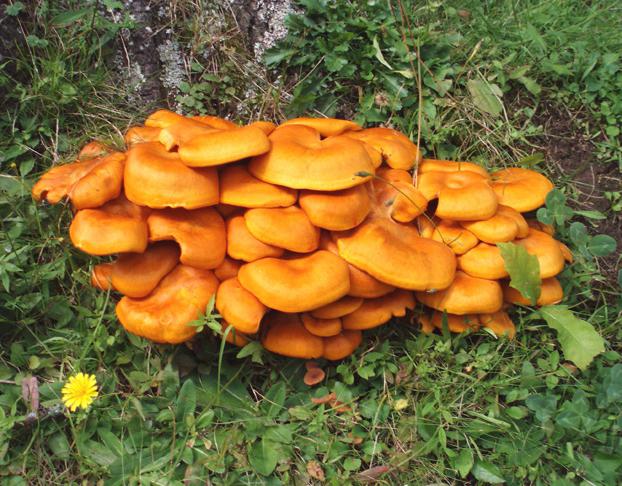
Cooking secrets
What chanterelle mushrooms look like in finished form? There is only one answer: very appetizing. They can be easily transported, remain unchanged in almost any conditions and are perfectly stored even for a long time. It is customary to fry, salt, pickle and dry chanterelles; there are a great many ways to prepare them. Good hostesses recommend to pre-evaporate from them excess water, and only then subject to frying. 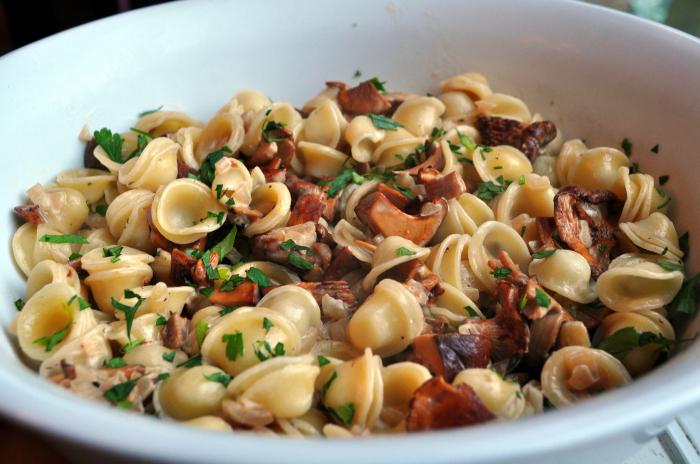
Where to look for chanterelles?
To reap a good harvest, you need to know the secret places where chanterelles (mushrooms) are found. Where do these representatives of the forest kingdom grow? Most often they can be found in birch groves or among conifers, in open sunny glades or deep in moss. Chanterelles grow in whole families, if you meet one mushroom, then there is another nearby. As for the time period, they can be collected over a fairly long period, both in summer and early autumn. August can be considered the most favorable. Chanterelles are mushrooms, photos of which will be a worthy reminder of a beautiful autumn. They are as bright as the leaves of trees, so they can often be overlooked during periods of heavy leaf fall.

